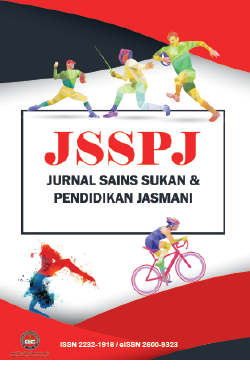Biochemical profile of Elite Army personnel
DOI:
https://doi.org/10.37134/jsspj.vol10.2.8.2021Keywords:
Biochemical profile, physical training, commandoAbstract
The main purpose of this study was to determine biochemical profile of an elite army personnel post-participation in a 12-weeks physically demanding commando training. Thirty seven elite army personnel aged 22.3 ± 2.85 years old with 1.71 ± 0.03 m body height and 60.11±4.66 kg body weight had participated in this study. Post-training blood samples (3 ml of the blood for the EDTA tube. 1 ml of the blood for the Fluoride Oxalate tube, and 4 ml for the plain tube) via phlebotomy procedures were drawn from the participants. The blood samples withdrawn were then analysed by qualified pathology laboratory. Results indicated that average haemoglobin readings were 13.72 ± .920 g/dl, neutrophils 60.54 ± 7.48 %/mcL, sodium 137.16 ± 2.30 mmol/L, potassium 3.79 ± .089 mmol/L and creatinine 109.21 ± 11.63 μmol/L respectively. In conclusion the results indicated significant negative impact of the training on overall biochemical response, which indicated normal physical health were intact post-training. In practical, army physical trainer may benefitted from biochemical assessment especially post high volume and high intensity physical training performed in a quite longitudinal period of time.
Downloads
References
Clase, C. (2011). Renal failure (chronic). BMJ clinical evidence, 2011.
Dimitriou, L., Lockey, J., & Castell, L. (2017). Is baseline aerobic fitness associated with illness and attrition rate in military training?. BMJ Military Health, 163(1), 39-47.
Havenetidis, K. (2016). The use of creatine supplements in the military. BMJ Military Health, 162(4), 242-248.
Jeshurun, C. (1975). The Growth of the Malaysian Armed Forces, 1963-73. ISEAS Publishing.
Kjeldsen, K. P., & Schmidt, T. A. (2019). Potassium homoeostasis and pathophysiology of hyperkalaemia. European Heart Journal Supplements, 21(Supplement_A), A2-A5.
Marriott, B. M. (1994). Potassium Deficiency as the Result of Training in Hot Weather. In Fluid Replacement and Heat Stress. National Academies Press (US).
Moorthy, A. V., & Zimmerman, S. W. (1978). Human leukocyte response to an endurance race. European Journal of Applied Physiology and Occupational Physiology, 38(4), 271-276.
O'Brien, K. K., Montain, S. J., Corr, W. P., Sawka, M. N., Knapik, J. J., & Craig, S. C. (2001). Hyponatremia associated with overhydration in US Army trainees. Military Medicine, 166(5), 405-410.
Santtila, M., Pihlainen, K., Viskari, J., & Kyröläinen, H. (2015). Optimal physical training during military basic training period. The Journal of Strength & Conditioning Research, 29, S154-S157.
Selye, H. (1976). Stress without distress. In Psychopathology of Human Adaptation (pp. 137-146). Springer, Boston, MA.
Taylor, M. K., Sausen, K. P., Potterat, E. G., Mujica-Parodi, L. R., Reis, J. P., Markham, A. E., & Taylor, D. L. (2007). Stressful military training: endocrine reactivity, performance, and psychological impact. Aviation, Space, and Environmental Medicine, 78(12), 1143-1149.
Tsai, K. Z., Lai, S. W., Hsieh, C. J., Lin, C. S., Lin, Y. P., Tsai, S. C., ... & Lin, G. M. (2019). Association between mild anemia and physical fitness in a military male cohort: The CHIEF study. Scientific Reports, 9(1), 1-7.
Warburton, D. E., Welsh, R. C., Haykowsky, M. J., Taylor, D. A., & Humen, D. P. (2002). Biochemical changes as a result of prolonged strenuous exercise. British Journal of Sports Medicine, 36(4), 301-303.
Weeks, S. R., McAuliffe, C. L., DuRussel, D., & Pasquina, P. F. (2010). Physiological and psychological fatigue in extreme conditions: the military example. Pm&r, 2(5), 438-441.





